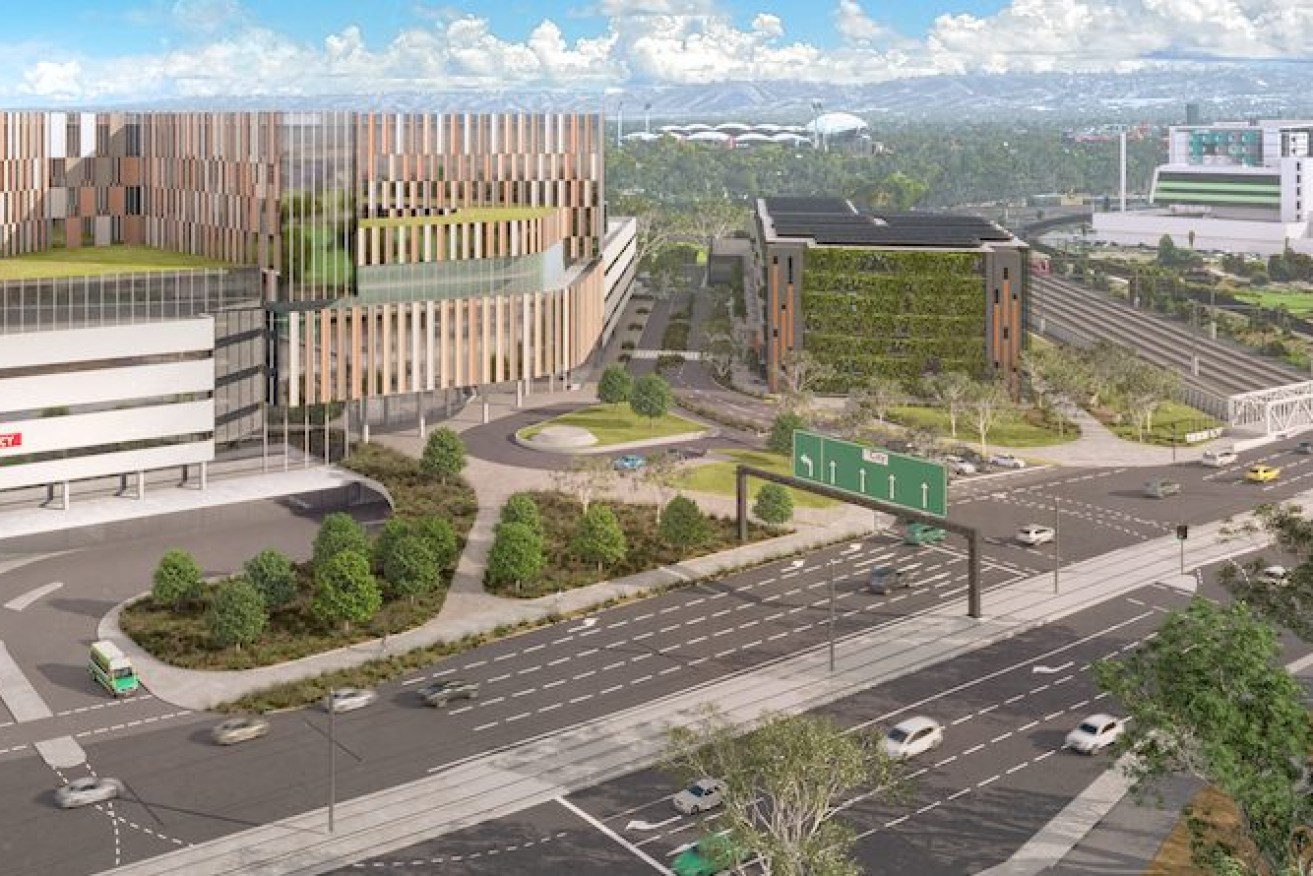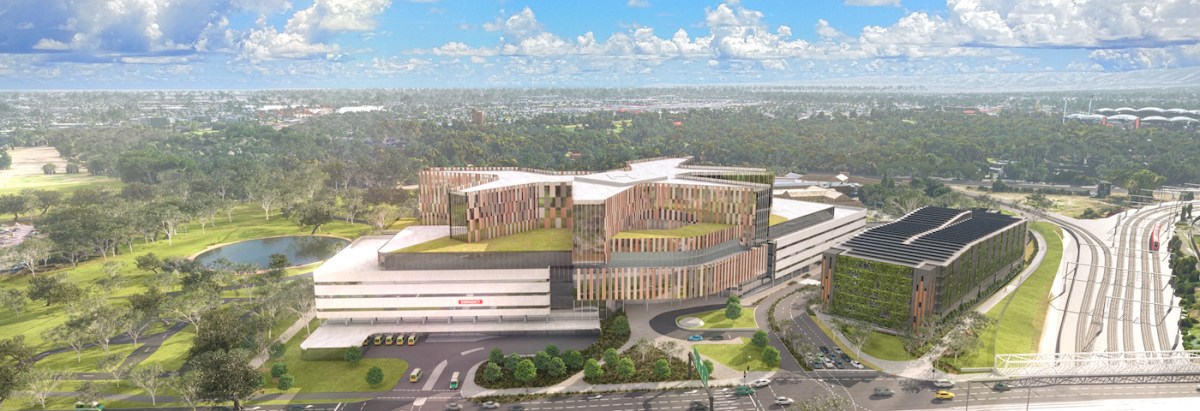Call to halt hospital park lands build over ‘flawed’ advice
Two independent engineering reports claim the State Government is building the new $3.2 billion Women’s and Children’s Hospital on park lands based on “seriously flawed” advice with calls for an immediate “critical independent review” of its findings.


Plans for the new Women's and Children's Hospital being built on city parklands. Photo: supplied
Separate reports written by two Institution of Engineers of Australia fellows criticise its site review that favoured building on the heritage-listed police barracks park lands site, both finding the Royal Adelaide Hospital West is a better option.
Senior civil engineering contractor Colin Best, who worked with engineers that built the nearby Adelaide Convention Centre over railway lines, rejected the review’s claim that there is not adequate land to expand the WCH and Royal Adelaide Hospital at RAH West.
The government’s site review was based only on an expensive, unnecessary option of undergrounding railway lines, according to Best, when building over existing railway lines would slash extra costs of demolishing and moving the existing Adelaide police barracks.
“It is this author’s view that the report of the review group is seriously flawed, and reliance on that report, accepted without further critical review, would commit the state to major unnecessary extra costs, and needless damage to heritage buildings and loss of parklands,” Best said.
Adding that “blinkered engineering prevented rail corridor solutions being considered”.
Best, who was previously Catcon’s design manager and SA, WA and NT infrastructure manager for engineering company Parsons Brinckerhoff, called for a “critical appraisal independent of government”.
Health Minister Chris Picton appointed independent chair Jim Hallion to conduct a “rapid review” of sites including the RAH West site selected by the former government in 2019, the Thebarton Police Barracks site, the city west site and a hybrid site between the barracks and RAH West.
Best, who is a member of the Liberal Party, described the site review as also being flawed by a “lack of inclusion of a traffic study in the report by road traffic experts” and that it only considered public transport.
“I was naturally very interested when I heard that rail issues were causing a major reversal in direction with the WCH with massive consequential impact on the parklands and heritage,” Best, who was also state manager for CSR subsidiary Betaform working on the substructure footings for the rail works under the Convention Centre, said.
It led to his extensive review of the report supporting the State Government decision to build on the police barracks site with Best saying “I believe that the minister has been poorly advised”.
Further concerns were raised by Best that there was not equal weighting in investigating important factors affecting the WCH build including the need to strengthen the Port Road bridge that would affect traffic driving into the city and hospitals.

Designs for the Women’s and Children’s Hospital being built on the existing heritage-listed Thebarton Police Barracks site. Photo: supplied
“In my experience over a number of major projects using this well-accepted methodology, that great care is needed …. Otherwise, the complex matrix can potentially result in the committee coming up with a wrong conclusion,” he said.
“It is then difficult to unwind the tangled web afterwards, especially if the decision is ‘sealed’ by an Act of Parliament.
“This is why I’m taking it so personally because it’s so obvious, this is 50 years of engineering experience, and I feel a responsibility to say I reckon if they move from the parklands site (currently chosen) it would be many hundreds of millions of dollars in savings.”
His report has been sent to Infrastructure and Transport Minister Tom Koutsantonis.
In a separate report, another leading former government chief civil engineer who did not wish to be named said he too is “firmly of the belief they (the government) have received flawed advice regarding the site for the RAH and the new WCH”.
This advice also found building on the RAH West site over the Adelaide Rail Yard would mean strong linkages between the proposed WCH and the RAH, saving the heritage-listed Thebarton barracks, and providing land for expansion.
And there would be “less expensive capital expenditure and lower operational costs”, the author calling for a halt to the design process.
“Notwithstanding the fact that legislation has been passed to enable the new WCH Option 2b to proceed (on the parklands), it is now blatantly clear the government would not be operating in the best interests of the state when the facts herein are brought to their attention,” his report said.
Best also said the site review the State Government used to pick the parklands site for the WCH failed to flag costs and road disruptions to the city and RAH after the Public Transport Working Group outlined the need for Port Road bridge upgrades.
He said the State Government based its decision on siting the hospital on a report where its list of working parties included one for public transport but not one looking at the impact on traffic around the decision.
Health Minister Chris Picton said that after winning government, ministers learned of budget and timeline blowouts associated with building the new hospital on land next to the RAH.
“Essentially the previous site was far too small to be able to fit a hospital that catered for future needs – with only one extra paediatric overnight bed planned, it would have been full the day it opened,” Picton said.
Former state coordinator-general Jim Hallion was appointed to lead the review that “engaged expertise across a range of disciplines including engineering and clinical advice, and concluded that the barracks site was the clear choice”.
“As the review considered, there isn’t enough width between tracks to build sufficient columns to withstand a freight train hitting them. To do that would require realignment of the tracks, lengthy closures of the freight and suburban lines and significant impacts to the Port Road bridge,” Picton said.
“Moving the project to the barracks site keeps the land next to the RAH for its original purpose, future-proofing the Royal Adelaide Hospital.
“The new site is double the size and allows a bigger hospital, meaning services such as ICU and operating theatres can be connected which was not possible previously.”
Picton said the new plan is supported by clinicians and the government is proceeding with support from the parliament last year.
“Last week’s release of the masterplan and block and stack was met with a positive response from clinicians and clinical consultation will continue throughout the project,” he said.




